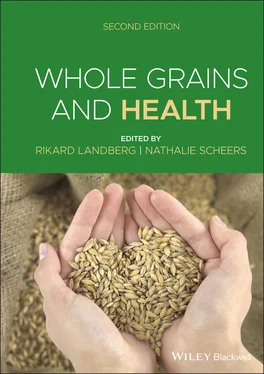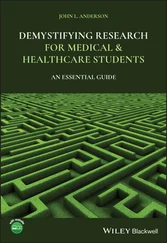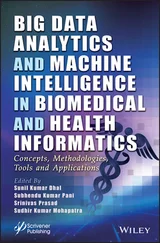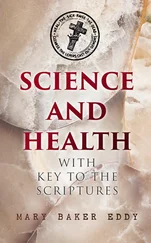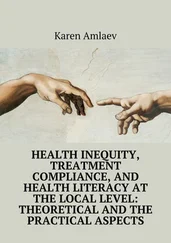1 Cover
2 Title Page
3 Copyright Page
4 Preface
5 Editors’ Biographies
6 Acknowledgments
7 Contributing Authors
8 Supplementary Material
9 1 The Structure of Cereal Grains and Their Products 1.1 Introduction 1.2 Grain structure 1.3 Embryo 1.4 Endosperm 1.5 Bran 1.6 Rolled cereals and porridge 1.7 Protein network‐based products 1.8 Starch network‐based products 1.9 Conclusions 1.10 References
10 2 Definition of Whole Grain and Determination of Content in Cereal Products 2.1 Introduction 2.2 Definition of whole grain in different countries 2.3 Definition of whole grain food 2.4 Recommendations for intake of whole grain foods 2.5 Dietary recommendations for whole grain intake 2.6 Markers for whole grain wheat and rye content in food 2.7 Effects of processing on whole grain 2.8 References
11 3 Whole grain Fractions and Their Utilization in Foods 3.1 Introduction 3.2 Cereal technologies to obtain fractions from whole grains 3.3 The starchy endosperm fraction – a good source of energy 3.4 The germ fraction – the most unstable of cereal fractions 3.5 Bran fractions – a source of micronutrients to exploit? 3.6 Innovative fractions 3.7 Conclusion 3.8 References
12 4 Whole grain Carbohydrates 4.1 Introduction 4.2 General composition of whole grain carbohydrates 4.3 Dietary fibre 4.4 Carbohydrate quality of whole grain foods 4.5 Slow digestion property of starch 4.6 Physical form of whole grain foods 4.7 Digestibility of dietary fibre 4.8 Phytochemicals 4.9 Future perspectives 4.10 References
13 5 Whole grain Content of Cereal Products 5.1 Introduction 5.2 Why is it important to know the whole grain content of food? 5.3 How can we better measure whole grain content and intake in the future? 5.4 References
14 6 Whole grain consumption and associated lifestyle and sociodemographic factors 6.1 Introduction 6.2 Global whole grain intake 6.3 Whole grain intake according to Mica et al. (2015) 6.4 Single studies of whole grain intake 6.5 Consumers of whole grains 6.6 Recommendations and compliance with recommendations 6.7 Different cereal and product sources of whole grains 6.8 Factors associated with whole grain intake 6.9 Acknowledgements 6.10 References
15 7 Alkylresorcinols and Their Metabolites as Biomarkers for Whole grain Wheat and Rye 7.1 Introduction 7.2 What is a biomarker? 7.3 Dietary biomarkers 7.4 Discovery and validation of a biomarker 7.5 Biomarkers of whole grain intake and cereal fibre 7.6 Alkylresorcinols as biomarkers of whole grain wheat and rye 7.7 Analytical methods 7.8 Dose‐response 7.9 Reproducibility 7.10 Relative validity 7.11 Applications 7.12 Interventions 7.13 References
16 8 Body Composition and Weight Management 8.1 Introduction 8.2 Obesity prevalence around the globe 8.3 Abdominal adiposity and cardiometabolic risk 8.4 Studies investigating the link between body weight and whole grain consumption 8.5 Defining grain ingredients and foods in observational studies 8.6 Defining grain ingredients and foods in intervention studies 8.7 Evidence from observational studies 8.8 Intervention studies 8.9 Studies without calorie‐restriction 8.10 Studies with calorie‐restriction 8.11 Proposed mechanism of action by which whole grains influence weight gain 8.12 Conclusion 8.13 Acknowledgements 8.14 References
17 9 Whole Grains and Type 2 Diabetes 9.1 Introduction 9.2 Evidence from epidemiological studies 9.3 Evidence from randomized controlled trials 9.4 Potential biological mechanisms 9.5 Conclusions and future directions References
18 10 Whole Grains and Cardiovascular Disease 10.1 Introduction 10.2 Whole grains and CVD 10.3 Summary 10.4 References
19 11 Whole Grains and Cancer Risk 11.1 Introduction 11.2 Diet and cancer 11.3 Dietary fibre and colorectal cancer risk 11.4 Possible cancer protective mechanisms 11.5 Colorectal cancer 11.6 Breast cancer 11.7 Other cancers 11.8 Cancer patients and prognosis 11.9 Epidemiological evidence – colorectal cancer 11.10 Epidemiological evidence – breast cancer 11.11 Epidemiological evidence – prostate cancer 11.12 Epidemiological evidence – endometrial cancer 11.13 Epidemiological evidence – stomach cancer 11.14 Epidemiological evidence – whole grains and cancer prognosis 11.15 Conclusion 11.16 Acknowledgments 11.17 References
20 12 Whole Grain Intake and Mortality 12.1 Introduction 12.2 Epidemiological evidence 12.3 Types of whole grain products and varieties of grain 12.4 Dietary patterns with whole grains and mortality 12.5 Human intervention studies 12.6 Cell and animal studies 12.7 Conclusion 12.8 References
21 13 Whole Grains and Appetite 13.1 Introduction 13.2 Acute effects of whole grain intake on appetite 13.3 Potential mechanisms of acute effects of whole grain intake on appetite 13.4 Impact of whole grain characteristics on appetite and suggested mechanisms 13.5 Second‐meal effects of whole grain intake on appetite 13.6 Influence of whole grain characteristics on appetite and suggested mechanisms 13.7 Long‐term effects of regular whole grain intake on appetite 13.8 Concluding remarks 13.9 References
22 14 Modulating Glycaemia with Cereal Products 14.1 Introduction 14.2 Postprandial glucose fluxes and hormonal responses determining glycaemia 14.3 Postprandial glucose fluxes – monitoring with the stable isotope technique 14.4 Glycaemia and underlying glucose fluxes – results of isotope studies 14.5 Food factors influencing GIP release 14.6 Food factors influencing GLP‐1 release 14.7 Conclusion 14.8 General implications 14.9 References
23 15 Whole Grains, Cereal Fibre and the Gut Function 15.1 Introduction 15.2 Whole grains and influence on gut physiology 15.3 The intestinal gut microbiome 15.4 Microbial fermentation end‐products and their impact for gut function 15.5 Microbiome mediated benefits of whole grain consumption 15.6 References
24 16 Bioactive Compounds in Whole Grains and Their Implications for Health 16.1 Introduction 16.2 Folate 16.3 Glycine betaine, choline and trigonelline 16.4 Tocopherols and tocotrienols 16.5 Carotenoids 16.6 Plant Sterols 16.7 Inositol phosphates 16.8 Lignans 16.9 Phenolic acids 16.10 Avenanthramides 16.11 Benzoxazinoids 16.12 Alkylresorcinols 16.13 References
25 17 Potential Negative Effects of Whole grain Consumption 17.1 Introduction 17.2 Allergies associated with grain intake 17.3 Non‐allergic conditions associated with wheat, barley and rye intake 17.4 The heavy metal cadmium 17.5 The mineral absorption inhibitor phytate 17.6 Anti‐nutrient properties of phenolic compounds 17.7 The heat‐induced toxicant acrylamide 17.8 Conclusion and future perspectives 17.9 References
26 18 Application of Metabolomics for the Assessment of Process‐induced Changes in Whole Grain Foods 18.1 Introduction 18.2 Targeted versus untargeted approaches 18.3 Bioactive compounds present in whole grain cereals 18.4 Processing of grains 18.5 Milling 18.6 Germination and malting 18.7 Soaking/hydrothermal processing of grains 18.8 Baking and roasting 18.9 Pasta processing and extrusion cooking 18.10 Fermentation and bioprocessing 18.11 Bioactives in human intervention studies 18.12 Conclusion 18.13 References
27 19 Application of Metabolomics for the Assessment of Health Effects of Whole grain Foods 19.1 Introduction 19.2 Study designs 19.3 Metabolomics in epidemiological studies on whole grains and health 19.4 Whole grain research on animal models utilizing metabolomics 19.5 Conclusion and future prospects 19.6 References
28 20 Using Transcriptomics and RNA Sequencing to Assess Health Effects of Whole Grains 20.1 Introduction 20.2 Transcriptomics and RNA sequencing 20.3 Effects of whole grains on gene expression 20.4 Conclusion 20.5 References
29 21 Whole Grains from an Industry Perspective 21.1 Introduction 21.2 Whole grains in foods 21.3 Whole grain raw materials 21.4 Whole grains in manufactured foods 21.5 Whole grains in extruded products 21.6 Sensory characteristics 21.7 Whole grains and food safety 21.8 Outlook and research needs 21.9 References
Читать дальше
